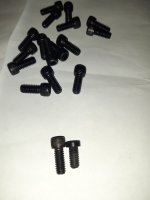I changed the Philips head screws on my bike to Allen screws, less hassle with torque, no screw head damage.
Spark plug thread repair was done by welding and tapping, the insert guy with the tap wanted too much money, and there were issues with head damage.
It was a Bajaj built bike under Kawasaki license, Japanese piston, carb., CDi and so on.
Spark plug thread repair was done by welding and tapping, the insert guy with the tap wanted too much money, and there were issues with head damage.
It was a Bajaj built bike under Kawasaki license, Japanese piston, carb., CDi and so on.
Hopefully I can learn something new here. How do you get the american thread pitch by measuring 10 threads length and dividing by 10. It gives you a distance between threads, not the thread pitch number. It's a number, but not a number anyone uses.Who mentioned millimeters?
Measuring length of 10 threads and then dividing by 10 is a universal way to get more precision, measurement scale is irrelevant.
Same with weighing 10 screws or anything else; it is averaging.
OK, missed that step. That would work.Use that number and diameter on the chart, which is easy to obtain.
Some Murican screws are defined by the major diameter and the number of threads per inch (TPI). 1/4-20, for example. TPI is not the same as the thread pitch. Smaller screws are defined by some pseudo-random gauge number and the number of threads per inch (#4-40 is a common one).This won't work for American threads. Pitch is designated as threads per inch. The method above does work for metric threads, which is number of threads per millimeter.
Metric screws are defined my the major diameter and the thread pitch (distance between the threads). An M3x0.5 mm machine screw will be 3 mm in diameter with 0.5 mm between threads.
Tom
"Distance between threads" IS the thread pitch.Hopefully I can learn something new here. How do you get the american thread pitch by measuring 10 threads length and dividing by 10. It gives you a distance between threads, not the thread pitch number. It's a number, but not a number anyone uses.
It is THE number everyone uses, why would you think they are different things?
https://www.sciencedirect.com/topics/engineering/thread-pitch
The thread pitch is the distance between corresponding points on adjacent threads. Measurements must be taken parallel to the thread axis.

When measuring small things where ruler/caliper tolerances bother since they are comparable to what you are measuring, a common trick and which is perfectly fine is to measure "x times" of anything and then divide by x to get a better average value, where error itself is divided by X
Practical example: a common silicon steel lamination thickness is 0.35 mm.
To measure it with any precision I need a micrometer, at least, capable of measuring, say, 0.01 mm as its smallest division/graduation.
But i can also measure the whole transformer stack with a caliper, even a steel ruler, count laminations and divide stack thickness by that number, for a very good approximation with easier to find instruments.
Try to measure 0.35mm on its own using a ruler and your naked eye 😉
Intojazz asked for some news.
I am glad to announce it was the good size. Just the head pitch size is different. Former was 1/8" and the new is bigger .
The former is the little at the rigth with half head size. I purchased an imperial Allen Keys set as well. 3/16" is the needed key now 🙂 !
I am glad to announce it was the good size. Just the head pitch size is different. Former was 1/8" and the new is bigger .
The former is the little at the rigth with half head size. I purchased an imperial Allen Keys set as well. 3/16" is the needed key now 🙂 !
Attachments
- Home
- Design & Build
- Parts
- American screw... needs help please
